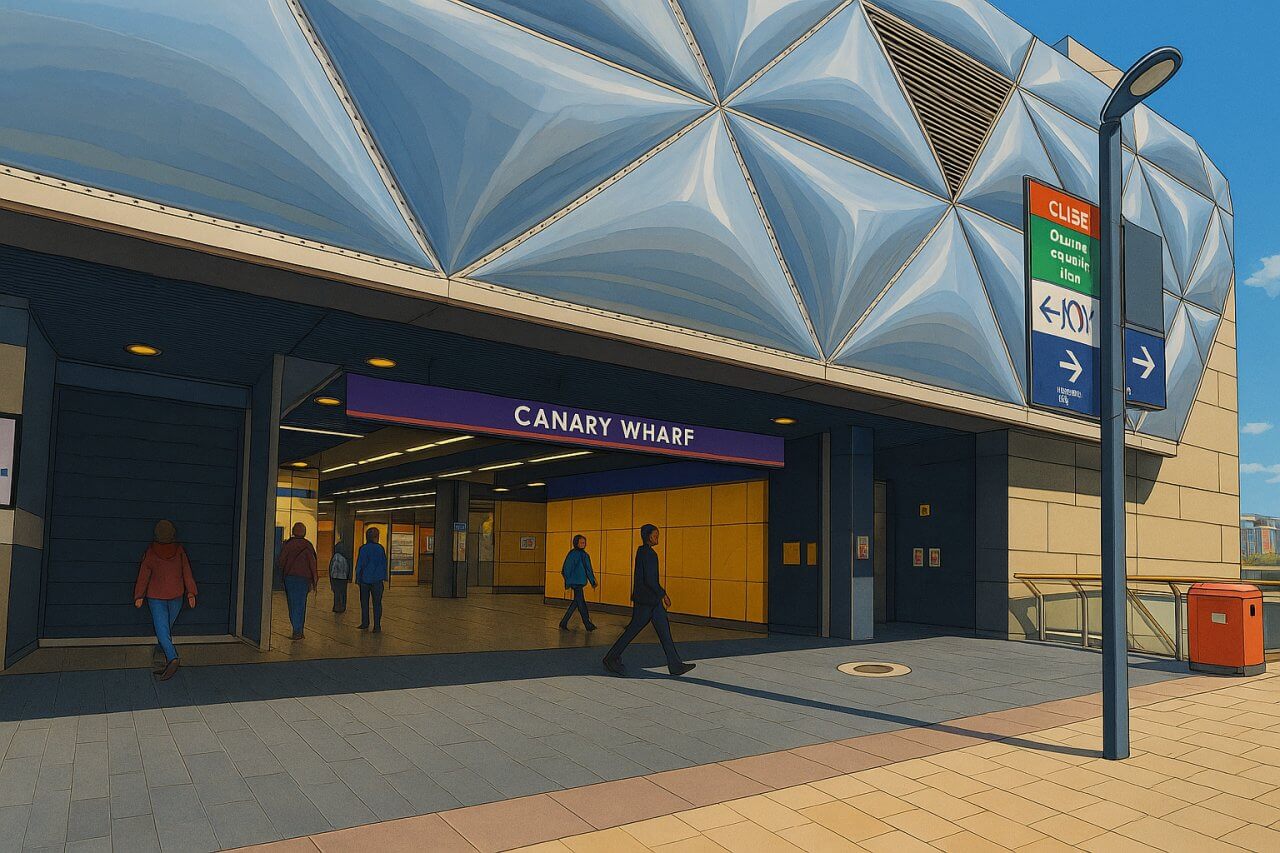
Canary Wharf Station, London
Canary Wharf Station is a major multimodal transport hub in the London Borough of Tower Hamlets, located in the financial heart of London's Docklands area. It is one of the busiest interchanges in Greater London, connecting three vital transport services: the London Underground, the Docklands Light Railway (DLR), and the Elizabeth Line.
Three Stations, One Destination
Despite sharing the same name, the Canary Wharf Station complex comprises three separate but interlinked stations serving different rail services:
- Jubilee Line Station – part of the Jubilee Line on the London Underground Stations network.
- DLR Station – elevated and located just north of the Jubilee Line entrance.
- Elizabeth Line Station – situated beneath the new Crossrail Place development, approximately 250 metres from the Jubilee Line station, but connected via a concourse and underground passages.
Historical Background
The first part of the station to open was the DLR station in 1991, constructed to serve the emerging Docklands business district. The Jubilee Line station followed in 1999, opened as part of the Jubilee Line Extension project. The Elizabeth Line station, built as part of the Crossrail project, opened to the public on 24 May 2022.
How Did It Get Its Name?
The station is named after the surrounding area of Canary Wharf, a former dock that was once a major hub for importing bananas from the Canary Islands—hence the name. The name "Canary Wharf" was already in use before the station was conceived, and the station adopted this established identity from the outset.
Station Architecture and Layout
The Jubilee Line station is famed for its modern, cavernous design by Sir Norman Foster, with a cathedral-like underground hall that is among the largest on the Underground network. The entrance is marked by a distinctive glass canopy rising from the landscape of Jubilee Park.
The Elizabeth Line station is housed within the sleek Crossrail Place development—a combination of transport interchange and commercial complex. The station lies below a striking timber lattice roof housing retail outlets, gardens, and event spaces above.
The DLR station is a more conventional elevated structure with open platforms, offering views over the surrounding towers of Canary Wharf.
Distance from Charing Cross
By road, Canary Wharf Station lies approximately 5.5 miles (8.9 km) east of Charing Cross, a journey that takes around 25–30 minutes by car depending on traffic.
Rail Services Available
Canary Wharf offers a wide range of rail connections:
- London Underground: Served by the Jubilee Line
- Docklands Light Railway: Frequent automated light rail service
- Elizabeth Line: High-capacity regional rail service through the City, West End, Heathrow, and beyond
Jubilee Line Connections
On the Jubilee Line, the preceding station westbound is North Greenwich, and the subsequent station heading west is Canada Water.
Elizabeth Line Connections
On the Elizabeth Line, the station is situated between Whitechapel to the west and Custom House to the east.
Fare Zones and Ticket Pricing
Canary Wharf Station lies in Travelcard Zone 2. Below are some sample fare costs and estimated journey times:
To Reading Station (Elizabeth Line)
- Single ticket: £24.10
- Oyster/contactless: £15.10 (peak), £10.90 (off-peak)
- Estimated travel time: approx. 1 hour 5 minutes
To Shenfield Station (Elizabeth Line)
- Single ticket: £11.70
- Oyster/contactless: £8.00 (peak), £6.00 (off-peak)
- Estimated travel time: approx. 45 minutes
To Charing Cross Station
Canary Wharf does not have a direct line to Charing Cross, but you can travel via:
- Jubilee Line westbound to Westminster
- Transfer to the Bakerloo Line northbound to Charing Cross
- Single ticket: £4.70
- Oyster/contactless: £2.80 (peak), £2.70 (off-peak)
- Estimated travel time: approx. 18 minutes
Fun Fact
The Jubilee Line platforms at Canary Wharf featured in the 2002 James Bond film Die Another Day, disguised as part of an underground base in North Korea. The station’s cinematic, futuristic design has made it a popular filming location for science fiction and thriller movies.
Quick Facts
- Name: Canary Wharf Station
- Location: London Borough of Tower Hamlets
- Lines Served: Jubilee Line, Elizabeth Line, Docklands Light Railway
- Fare Zone: Zone 2
- Jubilee Line Neighbours: North Greenwich (east), Canada Water (west)
- Elizabeth Line Neighbours: Whitechapel (west), Custom House (east)
- Distance from Charing Cross: 5.5 miles (8.9 km)
- To Reading: £24.10 single, £15.10 peak Oyster, approx. 1h 5m
- To Shenfield: £11.70 single, £8.00 peak Oyster, approx. 45m
- To Charing Cross: £4.70 single, £2.80 peak Oyster, approx. 18m with interchange
- Opened: DLR (1991), Jubilee Line (1999), Elizabeth Line (2022)
- Architectural Style: Modern, with notable designs by Foster + Partners
- Fun Fact: Filming location for Die Another Day (2002)
Canary Wharf Station is  on the Map of London Underground
on the Map of London Underground

Painting of Canary Wharf Station, London (View image in full size)